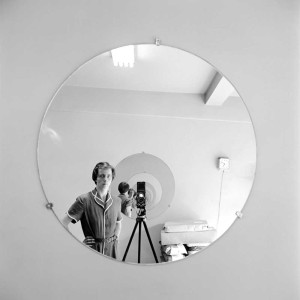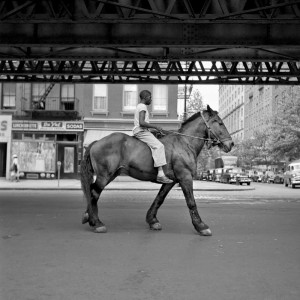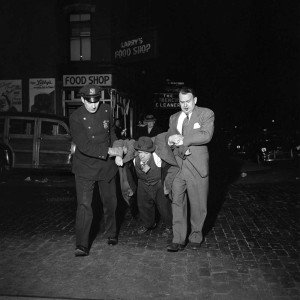
John Maloof, a real estate agent, stumbled upon a box full of old negatives at a local auction house and was immediately impressed by the images. As he continued studying the photographs, he realized they were the work of a master photographer. So the documentary of the late Vivian Maier, a nanny whose cache of over 100,000 street photographs had so moved Maloof, was born. During this time while Maloof researched Vivian Maier, he was looking for a collaborator. He was introduced to Charlie Siskel, an Emmy-nominated TV and film writer, director and producer. He is known for his work on the documentary Bowling for Columbine and Religulous. His TV work includes The Awful Truth with Michael Moore, Crossballs, Important Things, Tosh.0 and Review.
Maloof and Siskel set out to co-write and co-direct the film, with the former also serving as director of photography. The result is a documentary that has received a BAFTA nomination for best documentary and an Academy Award nomination for best feature documentary. “It is very exciting,” said Maloof, “it’s very surreal. We are thrilled to be nominated. It is an honor just to be nominated. We’re looking forward to the 22nd. It’s been a long journey to get to here and it’s been wonderful.”
The journey began with Maloof discovering Vivian Maier’s work in 2007. As he learned more about her, Maloof became fascinated with her mysterious life. “I was thirsty to learn more about her because there was nothing to really hang my hat on to say ‘this is what this photographer did or this is what this photographer is about, why they made it, this is where they worked.’ There was a lot of information that was missing that would be extremely important to me as a person who was uncovering this archive,” Maloof explained. Wanting to fill in these gaps, Maloof and Siskel set out on a detective’s mission to learn more about Vivian Maier and try to paint a portrait of her life.
 “We were making discoveries about Vivian Maier as the film was being made. Siskel and I were doing the research, looking for evidence, trying to piece the puzzle pieces together. What was addictive about this whole story is that you’re making discoveries and you want to learn more,” Maloof noted. By the way the story is put together the viewer experiences this same journey that Maloof and Siskel are on. The goal was to see a mystery unfolding before your eyes. “It’s an incredible story,” added Siskel. “It’s a story of an undiscovered talent being discovered and finally getting the recognition that she deserves.”
“We were making discoveries about Vivian Maier as the film was being made. Siskel and I were doing the research, looking for evidence, trying to piece the puzzle pieces together. What was addictive about this whole story is that you’re making discoveries and you want to learn more,” Maloof noted. By the way the story is put together the viewer experiences this same journey that Maloof and Siskel are on. The goal was to see a mystery unfolding before your eyes. “It’s an incredible story,” added Siskel. “It’s a story of an undiscovered talent being discovered and finally getting the recognition that she deserves.”
The writing of the documentary was an interesting process. Writing takes on a different form when it’s a documentary. Sometimes it’s writing voiceover, which this film doesn’t have much of, but this did involve outlining and creating a narrative structure. It’s the same way as if you were writing a fictional film, only in this case, all the material to work with is already there and you are just piecing it together. “Writing isn’t the same thing as writing a script with dialogue, writing this film took the form of shaping these interviews and making decisions that I thoroughly think of as writing decisions, in terms of what we were going to shoot and how we were going to put together a story. If the film was a detective story, how that detective story would have a beginning, middle and end,” Siskel said. “This is not entirely scripted out detail by detail, but we know the pieces that we’re going to put together. We do a lot of outlining, see how stuff works, rework it until the story we’re trying to tell is as powerful as can be,” Maloof noted.
Making a film this way, out of a chaotic array of evidence was a definite challenge. In the beginning, it especially felt overwhelming and as Maloof and Siskel began following leads, it lead to more leads and there became an endless amount of leads that it felt as though they were never going to get caught up. “It’s tough,” Maloof explained. “It took years. It took a lot of research, a lot of people, experts and genealogists and private investigators and sifting through clues to find basically the subject and other things such as where she went to make this film feel fluffed out because that is essentially what fills the film up with content.”
 Editor Aaron Wickenden was the first editor to work on the film, but several different editors contributed to the film. “The editors bring a lot to the table. I could say that they have great vision of how we want it executed and they have all the tools to do it. So there’s definitely a lot to be said about the value that they bring to this project,” Siskel said.
Editor Aaron Wickenden was the first editor to work on the film, but several different editors contributed to the film. “The editors bring a lot to the table. I could say that they have great vision of how we want it executed and they have all the tools to do it. So there’s definitely a lot to be said about the value that they bring to this project,” Siskel said.
The photography of the film by Maloof happened because he was inspired by Vivian Maier to pick up photography. The film was shot on a Canon T3i which is similar to the Canon 70, but with more limited options. Maloof used very good lenses that were made for older cameras. “So the look that those lenses can give are sort of creamy cinematic pictures but also we had a color corrector that made what I did even better. We decided to have the subject kind of looking into the lens so it seems like they’re talking to the viewer in a sense. That was one of the aesthetic choices we made early on when framing and organizing a shoot,” Maloof said.
Making this documentary was especially satisfying for both filmmakers. What began as two strangers meeting turned into the ideal collaboration. “The process of making the film over so many years and really getting to know Maloof and to work so closely on something like this has been just an incredible gift,” Siskel said.





